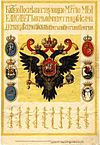This article needs additional citations for verification. (October 2024) |
Kalmyk Khanate Kalmyk: Хальмг хана улс | |||||||||||||
|---|---|---|---|---|---|---|---|---|---|---|---|---|---|
| 1630–1771 | |||||||||||||
|
Banner granted by Elizabeth of Russia to Donduk Dashi as a Khan of Kalmykia | |||||||||||||
| State Seal of Ayuka Khan: | |||||||||||||
 Map of the Kalmyk Khanate | |||||||||||||
| Status | Khanate | ||||||||||||
| Capital | Ayuka Khan's residence (1697–1724) | ||||||||||||
| Common languages | Kalmyk, Russian | ||||||||||||
| Religion | Tibetan Buddhism (Gelug, Karma Kagyu) | ||||||||||||
| Government | Hereditary monarchy | ||||||||||||
• died 1644 | Kho Orluk | ||||||||||||
• 1669–1724 | Ayuka Khan | ||||||||||||
| History | |||||||||||||
• Established | 1630 | ||||||||||||
• Annexed by Russia | 1771 | ||||||||||||
| |||||||||||||
The Kalmyk Khanate (Kalmyk: Хальмг хана улс, Xal'mg xana uls) was an Oirat Mongol khanate on the Eurasian steppe. It extended over modern Kalmykia and surrounding areas in the North Caucasus, including Stavropol and Astrakhan. During their independence, the Kalmyks both raided[1] and allied with Russia in turn, engaging in numerous military expeditions against the Crimean Tatars, the Ottoman Empire, neighboring Muslim tribes, and the highlanders of the North Caucasus.[2] The Khanate was annexed by the Russian Empire in 1771.
- ^ Forsyth, James (1992). A History of the Peoples of Siberia: Russia's North Asian Colony 1581–1990. Cambridge University Press. p. 118. ISBN 978-0-521-40311-5.
For over a hundred years the Kalmyk alternately raided the southern borderlands of Russia.
- ^ "Republic of Kalmykia". Kommersant. 2004-03-10. Retrieved 2007-04-06. "The Kalmyk Khanate reached its peak of power in the period of Ayuka Khan (1669–1724). Protected the southern borders of Russia and conducted many military expeditions against the Crimean Tatars, Ottoman Empire and Kuban Tatars. He also waged wars against the Kazakhs, subjugated the Mangyshlak Turkmens, and made multiple expeditions against the highlanders of the North Caucasus."

